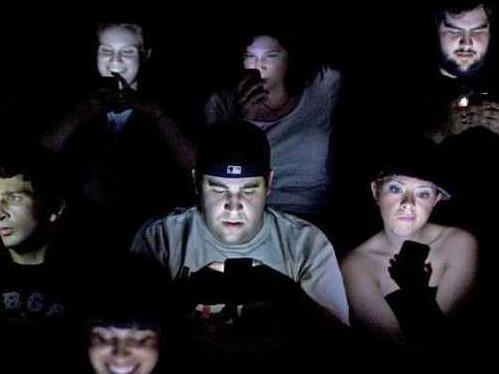As Alamo founder and CEO Tim League publicly recognised, their response was both serious and tongue-in-cheek, framed to raise awareness of the issue. Of course, many shared the same sentiments; though Madonna’s actions put a high-profile face to changing crowd behavior, the act that caused such attention is a sadly frequent occurrence in film and theatre sessions.
Dialogue surrounding acceptable conduct is ongoing, a product of times that see patrons glued to screens large and small for much of their waking hours, and increasingly unwilling to go without their technology fix for even a short period. Already, copious column inches have been dedicated to mobile phone etiquette in social situations: is it okay to check your emails while you’re with a friend; or text during after-work drinks; or tweet your dinner conversation? Now, the questions surround second screen usage, with tablets, laptops and phones becoming a crucial part of the watching experience. Although originally centred around television viewing, it was inevitable that the trend would migrate out of homes and into cinemas and theatres.
The data to support the prevalence of screen usage is prolific and plentiful, each new report reiterating the current love affair with on-the-move technology. According to the Australian Bureau of Statistics’ June 2013 investigation into Internet Activity, more than 19.6 million mobile handset subscribers have an internet connection. AIMIA’s September 2012 Australian Mobile Phone Lifestyle Index points to 70% of respondents owning a smartphone, with their use for entertainment purposes rising by 15% to 72% in the two years since the previous poll. In February 2013, the Yahoo!7 Social TV Survey found that 43% of respondents used social media while watching television. The Mi9 Always On report shows that 68% of audiences are “content grazing”, or using two or more screens simultaneously. Nielsen’s annual Australian Connected Consumers survey boasted a larger figure, stating 74% of online Australian’s engaging in simultaneous screen use.
At the same time as phones and hand-held screens form a larger part of the viewing equation, audiences are still seeking entertainment that screams for singular attention, with cinema and theatre patronage remaining healthy. The Motion Picture Distributors Association of Australia reported a 2012 box office total of $1.125 billion, a 2.8% increase from 2011, bolstered by big-budget franchise efforts The Avengers, Skyfall and The Dark Knight Rises. Their theatre counterpart, Live Performance Australia, claimed that 2012 data shows the sector remains stable, generating $1.2 billion in revenue.
Where, then, does the line sit between engaging with content – or with the outside world – while watching, and enjoying the film or performance uninterrupted by the beeps and flashes of a tablet or mobile phone? That the area is shrouded in shades of grey is indicative of the murkiness of the issue, the politeness-driven traditional behavior of aural and visual silence, of refraining from talking, answering phones, and being otherwise distracting to fellow patrons in theatres, now clashing with other forms of media engagement and social, always-switched-on norms.
The rise of second screen engagement is perhaps best suited to television viewing, the advertisement-interrupted nature of the content affording a natural opportunity for pause, and the distinctive glow emitted by a phone or tablet unobtrusive and perfectly acceptable in your own living room. To this end, TV networks have begun to actively elicit online participation via their own apps and promoted Twitter hashtags; as the spate of live-tweeting during any popular program shows, viewers are eagerly joining in. It’s the watercooler effect, simply moved online for instant gratification.
It is far from surprising, then, that audiences are beginning to bring this behavior to cinemas and theatres; nor is the somewhat tentative encouragement shown by some film and performing arts establishments. Some venues, events and distributors have toyed with actively stimulating the supplementary screen experience, seen in dedicated “tweet-along” sessions, allocated “tweet seats” trialed during plays, and even the aptly-titled “Second Screen Live” re-release showings of The Little Mermaid, complete with a custom-made app for the occasion. These instances, however, are thankfully few and far between.
There remains a significant split in embracing the use of phones in theatres: put simply, some do and some don’t. For all the efforts to create events out of in-theatre content grazing, the more common manifestation comes simply out of habit or boredom or lack of thought for others, patrons sending text messages, updating their Facebook status, and reading and sending unrelated tweets rather than simultaneously extending their viewing experience into the online realm.
The are old cinema staple of “shushing” prompted an online war last year between those deeming the practice antiquated and out of line with the times, and those fighting for the sanctity of the theatre experience. Commencing with a blog post by the tech-focused Hunter Walk , and further fuelled by an article by writer and entrepreneur Anil Danish inflammatorily entitled “Shushers: Wrong About Movies. Wrong About the World”, heated words were exchanged, with a plethora of respected film sites weighing in; similarly, social media was set alight with opinion. Even Elijah Wood, best known as the star of the Lord of the Rings trilogy, offered his thoughts – firmly against talking and texting in cinemas – via Twitter.
At the heart of the matter, of course, is the treatment of cinemas and theatres as lounge rooms where the activity and intrusion of multi-tasking behaviour is acceptable, not as communal spaces of quiet and passive consumption where the enjoyment of others is also a cause for consideration. For all the angry answers on both sides, the conflict surrounding the evolving viewing experience stems from its decreasing prominence; for some, going to see a movie or a play is special and sacred, for others it’s just another stage or screen amongst the many others calling for concurrent attention.
Those organisations and establishments that aren’t testing the space are standing up for the old-fashioned ways of watching. The days of uppity ushers asking audiences to be quiet have long since passed, fading with the effectiveness of their methods. In London, “cinema ninjas” have been employed to stealthily shock and admonish those displaying poor conduct. And long before their anti-Madonna stance attained infamy, the Alamo Drafthouse’s “Don’t Talk” pre-screening public service announcements – recently featuring James Franco, The World’s End cast, Machete Kills’ titular character, Before Midnight’s Ethan Hawke and Julie Delpy, and more – were viral sensations.
The trend hasn’t escaped the notice of the talent behind the lens, either. During his October visit to Australia as part of the Melbourne Festival, veteran director John Landis (An American Werewolf in London, The Blues Brothers) shared a story sparked by an email from fellow filmmaker Joe Dante (The Howling, Gremlins), inspired by the aforementioned Little Mermaid campaign. “Oh, that’s what I want to see when I go to the movies – some kid with an iPad,” Landis told the crowd. The audience clapped in agreement.
The future, of course, is uncertain: every public outcry, amplified by bad celebrity behaviour, or augmented by articles written to the contrary, is dwarfed by the constant reality of talking, texting and second screen use in almost every film and theatre session. The only constant, and not for the better: viewing filmed or performed art in a darkened room, sans distractions and interruptions, is an increasingly rare experience.





